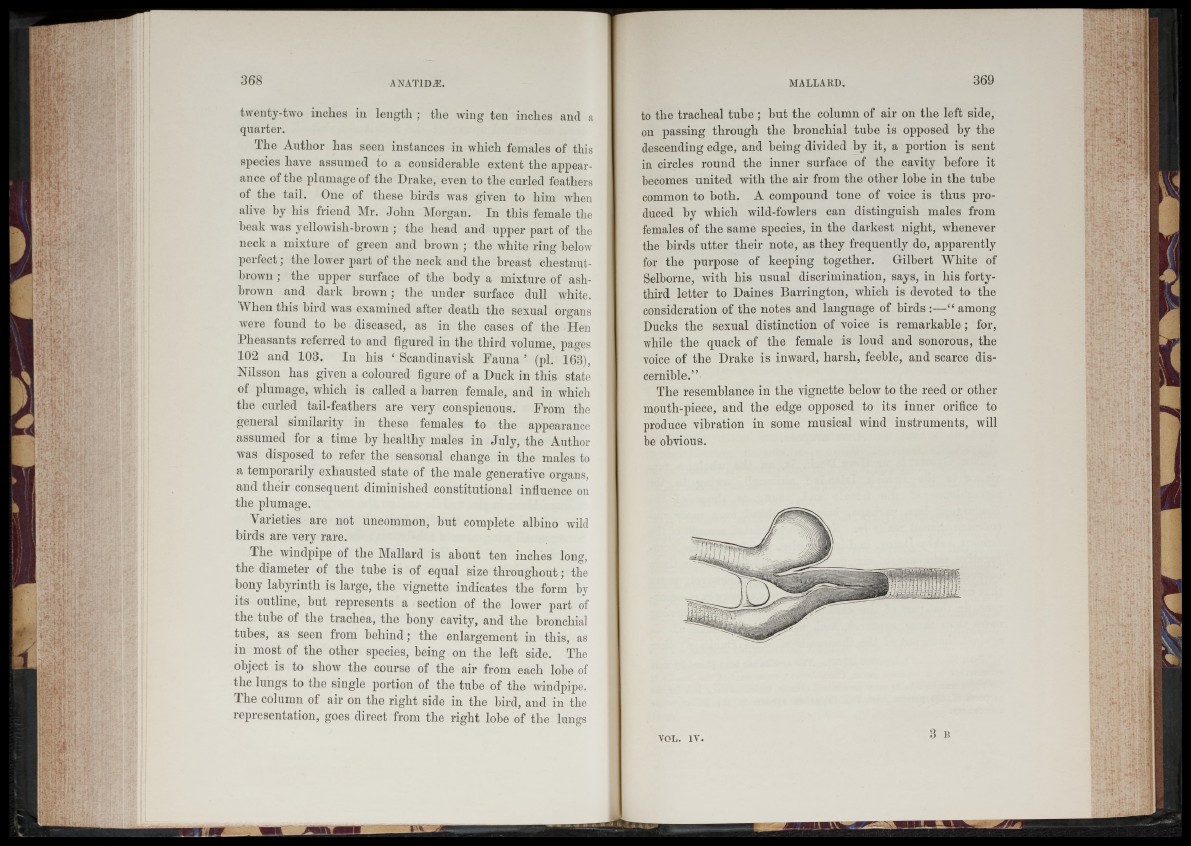
twenty-two inches in length ; the wing ten inches and a
quarter.
The Author has seen instances in which females of this
species have assumed to a considerable extent the appearance
of the plumage of the Drake, even to the curled feathers
of the tail. One of these birds wTas given to him when
alive by his friend Mr. John Morgan. In this female the
beak was yellowish-brown ; the head and upper part of the
neck a mixture of green and brown ; the white ring below
perfect; the lower part of the neck and the breast chestnut-
brown ; the upper surface of the body a mixture of ash-
brown and dark brown; the under surface dull white.
When this bird was examined after death the sexual organs
were found to be diseased, as in the cases of the Hen
Pheasants referred to and figured in the third volume, pages
102 and 108. In his ‘ Scandinavisk Fauna ’ (pi. 163),
Nilsson has given a coloured figure of a Duck in this state
of plumage, which is called a barren female, and in which
the curled tail-feathers are very conspicuous. From the
general similarity in these females to the appearance
assumed for a time by healthy males in July, the Author
was disposed to refer the seasonal change in the males to
a temporarily exhausted state of the male generative organs,
and their consequent diminished constitutional influence on
the plumage.
Varieties are not uncommon, but complete albino wild
birds are very rare.
The windpipe of the Mallard is about ten inches long,
the diameter of the tube is of equal size throughout; the
bony labyrinth is large, the vignette indicates the form by
its outline, but represents a section of the lower part of
the tube of the trachea, the bony cavity, and the bronchial
tubes, as seen from behind; the enlargement in this, as
in most of the other species, being on the left side. The
object is to show the course of the air from each lobe of
the lungs to the single portion of the tube of the windpipe.
The column of air on the right side in the bird, and in the
lepresentation, goes direct from the right lobe of the lungs
to the tracheal tube ; but the column of air on the left side,
on passing through the bronchial tube is opposed by the
descending edge, and being divided by it, a portion is sent
in circles round the inner surface of the cavity before it
becomes united with the air from the other lobe in the tube
common to both. A compound tone of voice is thus produced
by which wild-fowlers can distinguish males from
females of the same species, in the darkest night, wdienever
the birds utter their note, as they frequently do, apparently
for the purpose of keeping together. Gilbert White of
Selborne, with his usual discrimination, says, in his forty-
third letter to Daines Barrington, which is devoted to the
consideration of the notes and language of birds “ among
Ducks the sexual distinction of voice is remarkable ; for,
while the quack of the female is loud and sonorous, the
voice of the Drake is inward, harsh, feeble, and scarce discernible.”
The resemblance in the vignette below to the reed or other
moutli-piece, and the edge opposed to its inner orifice to
produce vibration in some musical wind instruments, will
be obvious.
II
Jil
VOL. IV. 3 B
.
" ; 1 v , ' t ■ ..i
■
i l l w P
i, 1H' l*| ' L\1 If« “ill!